After living in New York for over a month, I can say how rich New York ethnicity is and culturally diverse it is with a vibrant mix of world influences. I am also amazed by the extensive range of cuisine available in New York. The diversity reminded me of Singapore where I grew up as it is also culturally diverse with four different cultures living together. Since English is the primary language spoken, most of the street signs are in English. Even at the Subway stations and the advertisement on the train are in English (Pictures below).

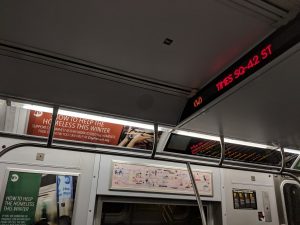
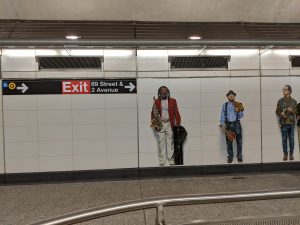
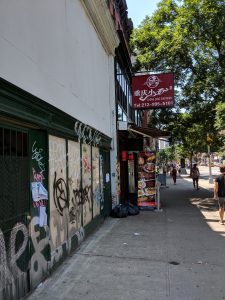
In “A contextualized approach to Linguistic” Leeman and Modan mention how “Material realizations of language are strategic tools that are wielded in local politics, power struggles, and competing claims to space” (pg 332). This is true, the fact that the United States is one of the leading and influential countries in terms of politics and business where New York is a global hub for business. The city does not need to conform its language to other foreigner languages, but foreigners will have to learn English to go around New York. However, New York is inhabited by people of different races and cultures and the dominance of English signs does not stop them from embracing their own culture. You could see it on the street where there would be people speaking in different languages from Polish to French. Even though English is prominent in its linguistic landscape in New York, the people living there makes it diverse by coming together to create their community.
New York is separated into five different boroughs: Bronx, Brooklyn, Manhattan, Queens and Staten Island. Each borough has its subset of culture where specific areas have a rich cultural origin. For example, in Manhattan, Harlem is a place rich in its African American and Caribbean culture. It is also the home of Jazz since I like listening to Jazz songs, this was one of the memorable places I have been to as I went to National Jazz Museum. I was surprised by how rich and explicit the culture is in that specific region.
However, unlike Harlem which is in the north of the city, areas that are in the city center (Manhattan) like Chinatown and Koreatown are not culturally authentic. There is a strong influence of western influence in those regions. Restaurants that have Chinese signs would have the English translation for the tourist. These translations are similar to what Leeman and Modan said about the Chinatown in Washington DC’s, “the state and private enterprise commodify language… turn Chinatown into a commodity, marketing it and the things in it for consumption” (Pictures of Chinatown below)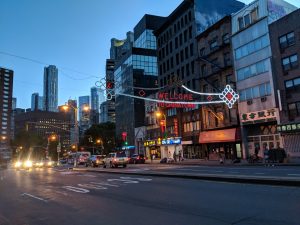
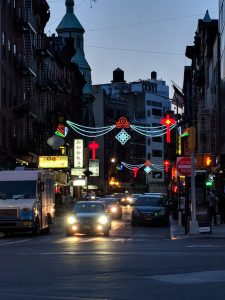
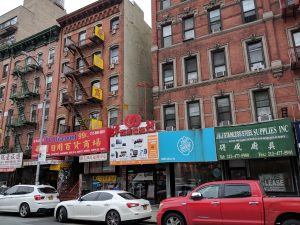
The Chinatown neon sign hanging above the area in English further prove the points how it is only a place for tourist to visit. That sign is for tourist to come to take a picture of it to show the “new culture” they have explored even though there were not much cultural history in that area. Tourists only go there to try “authentic” food. Furthermore, with the English translations on Chinese restaurants and English signs in Chinatown, tourists do not get to experience the Chinese culture fully. Chinatown has been gentrified and is becoming increasingly expensive causing traditional Chinese restaurant owners to not be able to afford the rent and have to move out of Manhattan.
However, in the area at Queens, Flushing. There is still a robust Asian culture there. I could tell the difference immediately as I noticed the majority of people in Flushing were all Asian, where there was an abundance of Chinese signs and traditional stores everywhere with not as much English translation compared to Chinatown. (Pictures of Flushing below)
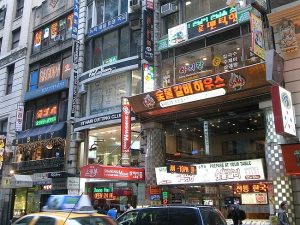
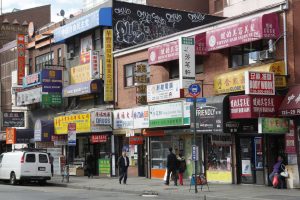
I remembered when I first got to Flushing. I thought I was in an Asian city. I admire how the Asian cultures are rich in Flushing and were happy that it had not been tainted with the Western influence like the Chinatown. Since most of the people were Asian, the people there mostly speaking in Asian language like Mandarin, Korean and Japanese.
New York is always changing and conforming to the influences of the world. The fact that there is limited space in the city center at Manhattan causes the process of gentrification to be faster causing some area to lose its culture turning it into the “Chinatown” of what Leeman and Modan said about Chinatown. I hope that culturally rich areas such as Harlem and Queens will be protected from the gentrification as that is what makes New York “New York”, with it being the culturally diverse city.
Sources:
Leeman, Jennifer, and Gabriella Modan. “Commodified Language in Chinatown: A Contextualized Approach to Linguistic landscape.” Journal of Sociolinguistics, vol. 13, no. 3, 2009, pp. 332–362., doi:10.1111/j.1467-9841.2009.00409.x.
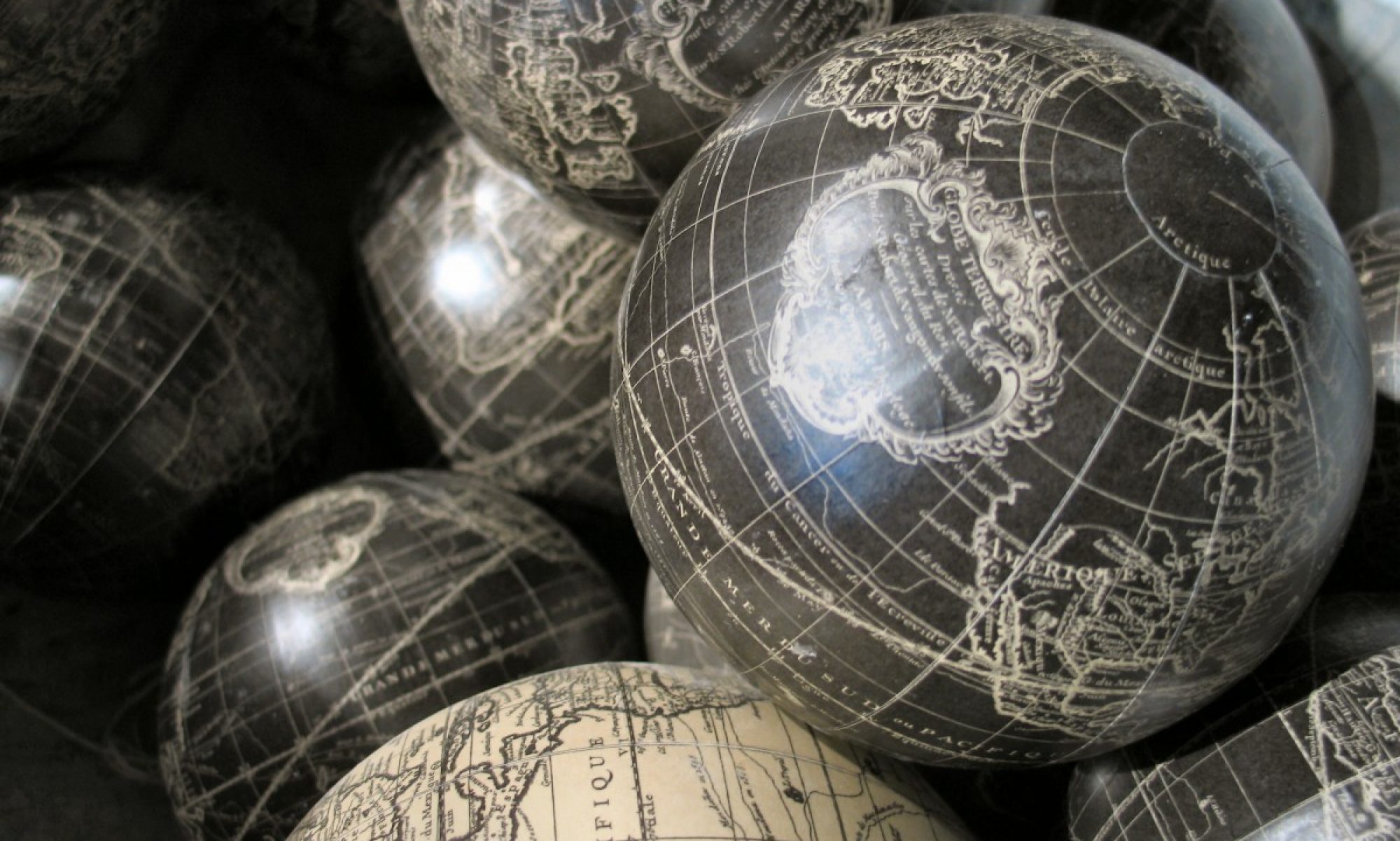
Hi TK! This was a really well written post, and I agree with a lot of the points that you brought up. I especially relate to what you said about how Chinatown has been tainted with Western influence. In Dublin City Center, there is a street called Capel Street, and although there are many asian stores and restaurants in this area, I realized that it was strongly influenced by the West. For example, the name of one Asian store is “Super Asia Foods” with the Chinese translation taking a smaller proportion of the sign.
Hi TK! This was a really well written post, and I agree with a lot of the points that you brought up. I especially relate to what you said about how Chinatown has been tainted with Western influence. In Dublin City Center, there is a street called Capel Street, and although there are many asian stores and restaurants in this area, I realized that it was strongly influenced by the West. For example, the name of one Asian store is “Super Asia Foods” with the Chinese translation taking a smaller proportion of the sign.
I enjoyed your analysis of New York, Thitikorn. I found it really interesting that the authenticity of the ethnic neighborhood being attenuated by proximity to the city center to be quite fascinating. I’m curious if you think this is exclusive to New York or if it applies to all major cities worldwide?
Hey Thitikorn! I find it fascinating that there is a “Chinatown” – a tourist attraction that has turned Chinese culture and language into a commodity – and an area with heavy direct Chinese influence. I like how you noted that you can tell the difference easily. This makes me think that people will soon start flooding to the more genuine of the two. I think our younger generation is less prone to falling for gimmicks than the older generations, and therefore will search for a more genuine “Chinatown” experience. All the issues the come with this shift, namely the prospect of gentrifying the area, is a whole different story.
Hi Thitikorn! I really enjoyed and felt like I could relate to parts of your posts especially because I am in Singapore right now! I feel like New York and Singapore are related in similar ways because just like you said they are both inhabited by people of different races and cultures, but the dominate language is English. Although English is the main form of communication, both in New York and Singapore I feel like you are constantly seeing so many people from other cultures and places who continue to embrace their own cultures and backgrounds. I really enjoyed reading your post!
Great post Thitikorn. I think it is really interesting that since the reading discussed an example of a westernized Chinatown so much, you were able to visit a real example of it in New York. More interesting than that though is the example of Flushing that you brought up. The fact that a place for tourists to revel in faux exoticism and an actual refuge for expats from different Asian cultures can exist in the same city might give Leeman and Modan something else to think about. The dominance of the English language is also interesting considering I have been living in Berlin, where English is just one of many languages people use to communicate, and despite German being the official language I don’t think anyone is really forced out of circumstance to learn German here.
Hi! I do agree with most of what you wrote in your blog. I find it interesting how you mentioned China town and Korea town are influenced by Western culture as Sally also agreed to. As a Korean, I can see how those towns just try to emphasize and make use of cultural elements to make it seem very “authentic” as also mentioned in the textbook.
Great post! I really enjoyed your analysis of the linguistic landscape of New York City and the comparison of the different neighborhoods here. As I have also been spending my time in New York City, I found that your comparisons of Koreatown in Manhattan and Flushing very interesting. Additionally, I also found your point about the city not conforming to other foreign languages very intriguing, but at the same time, I wonder if the inclusion of the various foreign languages in the culture of New York City is the very thing that contributes to the culture and influence that New York City has on the international platform.
This is awesome to read because I’m Korean and live just outside of New York City! I spend a lot of my time there and have come to know the areas pretty well including areas like Chinatown, Little Italy, and Flushing. Singapore actually reminds me a lot of New York in that it has small cultural hubs like these also
Hi, Thitikorn! I am glad your post also mentioned the westernized Chinatown culture. I found a lot of similarities between my observation of the San Francisco Chinatown and your description of the New York Chinatown: first being the use of Chinese letters in the purpose of attracting tourist instead of communicating with native speakers, and second being the “authentic” food that is offered for both tourists and local residents. I hope we can discuss more about the similarities and differences between the two Chinatown culture in class. Great post!
Hi! I thought this post was very well thought out and interesting. I was most interested in your comparison between Flushing and Chinatown, and I thought it was very interesting to hear about the differences between different Asian communities in New York City. I liked your point about how the English language of the city forces foreign people to conform but that the city is at the same time extremely diverse.